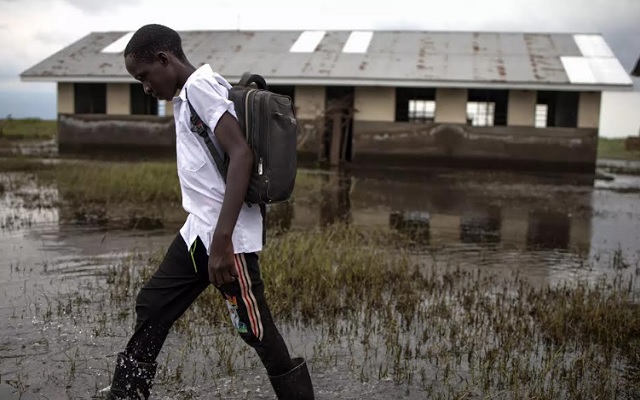
Migration agency to leverage tech giant’s AI expertise
ANALYSIS | RONALD MUSOKE | Microsoft, a U.S-based tech conglomerate has entered into partnership with the International Organisation for Migration of the UN (IOM) to address climate-induced displacement by harnessing artificial intelligence and data insights.
The partnership which the two entities entered into in September last year will see the tech giant leverage its artificial intelligence expertise on IOM’s on-the-ground operational footprint, human mobility knowledge and Displacement Tracking Matrix (DTM) data to develop scalable solutions to support at-risk communities.
Through innovative pilot projects with Microsoft’s AI for Good Lab in the Maldives, Ethiopia, and Libya, the collaboration aims to mitigate the impacts of climate change on migration and enhance resilience among vulnerable communities.
Climate change is a growing driver of displacement, with 26.4 million internal displacements recorded in 2023 alone. By the end of the year, 7.7 million people were left internally displaced due to disasters, according to a 2024 report from the Internal Displacement Monitoring Centre—the global source of data and analysis on internal displacement.
The scale of displacements triggered by weather-related events underscores the urgent need for more data highlighting the impacts of climate change on migration.
“We can no longer simply react to climate change,” said Amy Pope, the IOM Director General. “This collaboration with Microsoft empowers IOM with data and insights that enable us to proactively address the impact of climate change on migration so we can better protect vulnerable communities.”
In response to this growing crisis, IOM and Microsoft have combined advanced AI tools, local expertise, and data-driven insights to support communities impacted by climate-related risks and strengthen their resilience to future challenges.
“Our collaboration with IOM demonstrates how AI helps address the urgent challenges posed by climate-driven displacement,” said Dr. Juan Lavista Ferres, Chief Data Scientist and Director of Microsoft’s AI for Good Lab.
“These projects show how local teams on the ground can unlock insights with AI to anticipate risks and respond with solutions that improve the resilience of communities.”
Country-level pilot projects
Under the Climate Action Workstream, IOM joined the Microsoft AI for Good Lab in developing three country-level pilot projects, combining AI expertise with local, on-the-ground knowledge to help identify effective ways to support communities facing climate-related risks.
This collaboration leverages AI models trained on satellite data, climate projections, and IOM data to identify communities at risk, advancing the goal of averting, minimizing and addressing the impacts of climate change on these communities and enhancing their resilience.
By integrating these advanced technologies with local insights, IOM and Microsoft aim to develop proactive strategies that can be scaled and implemented globally. The results have been integrated into the upcoming Climate Action Portal in the format of interactive maps, as well as accompanying comprehensive reports for each country.
In Ethiopia, data analysis revealed that 700,000 people and 1.5% of the country’s croplands are at risk of flooding. This information enables IOM to plan more effective interventions, supporting displaced populations and reducing the likelihood of future displacement.
The partnership mapped flood-vulnerable communities using AI analysis of satellite imagery, population data, cropland maps, and IOM office locations.
The study identifies where an estimated 700,000 people and 1.5% of Ethiopia’s croplands are at risk, and the modalities of support that would be most effective in aiding these communities.
In the southeastern region near Somalia, 9% of the population living along the Shabelle River is situated in flood-prone areas, significantly exceeding the national average of 0.5%. Going forward, this data will assist IOM in evolving their preparation and planning strategies to better support displaced populations during future flooding events.
In Libya, research focused on the impact of extreme heat on migration pathways. Under a global warming scenario of 2°C, up to 72% of the country’s migration routes could experience dangerous heat levels, significantly increasing health risks for migrants.
The partnership mapped how extreme heat affects migrant journeys across Libya, revealing that climate change could dramatically increase risks. The study shows that areas with dangerous heat levels could expand from 8% to 72% of the total length of the mapped migration routes under a global 2°C warming scenario.
Many migrants, fleeing conflict in South Sudan, traverse these routes, and their health risks are significantly heightened by this projected increase.
Meanwhile, in the Maldives, projections indicate that by 2050, approximately 9,000 people could be displaced by rising sea levels. Some islands may see over 70% of their populations at risk, while the analysis identified five islands that are likely to remain safe.
The partnership combined AI population analysis with climate projections to identify 9,000 people in the Maldives at risk from sea level rise by 2050, with some islands experiencing over 70% of their populations at risk.
The analysis includes layers showing population changes from 2018 to 2023, highlighting new settlements in risk areas and mapping safe islands for potential relocation.
The identification of five islands likely to remain safe from sea-level rise can inform policy and preparation discussions for proactive migration proposals with the Maldivian government. According to the study, the findings are essential for guiding migration and adaptation policies in collaboration with the Maldivian government.
IOM and Microsoft will showcase the outcomes of the partnership through the Climate Action Portal, a platform that will offer key insights on climate change and migration. The Portal will present pilot results through interactive maps and dynamic data visualizations to empower policymakers and humanitarians with actionable insights.
This collaboration is part of a strategic partnership between IOM and Microsoft Philanthropies to leverage technology and data to save lives, drive solutions, and facilitate pathways and sustainable impact for migrants.
By combining the power of AI with local expertise, IOM and Microsoft are setting a new standard for identifying vulnerable populations, predicting displacement hotspots, and equipping decision-makers and humanitarian actors with the tools needed to mitigate risks and support at-risk communities.
 The Independent Uganda: You get the Truth we Pay the Price
The Independent Uganda: You get the Truth we Pay the Price



